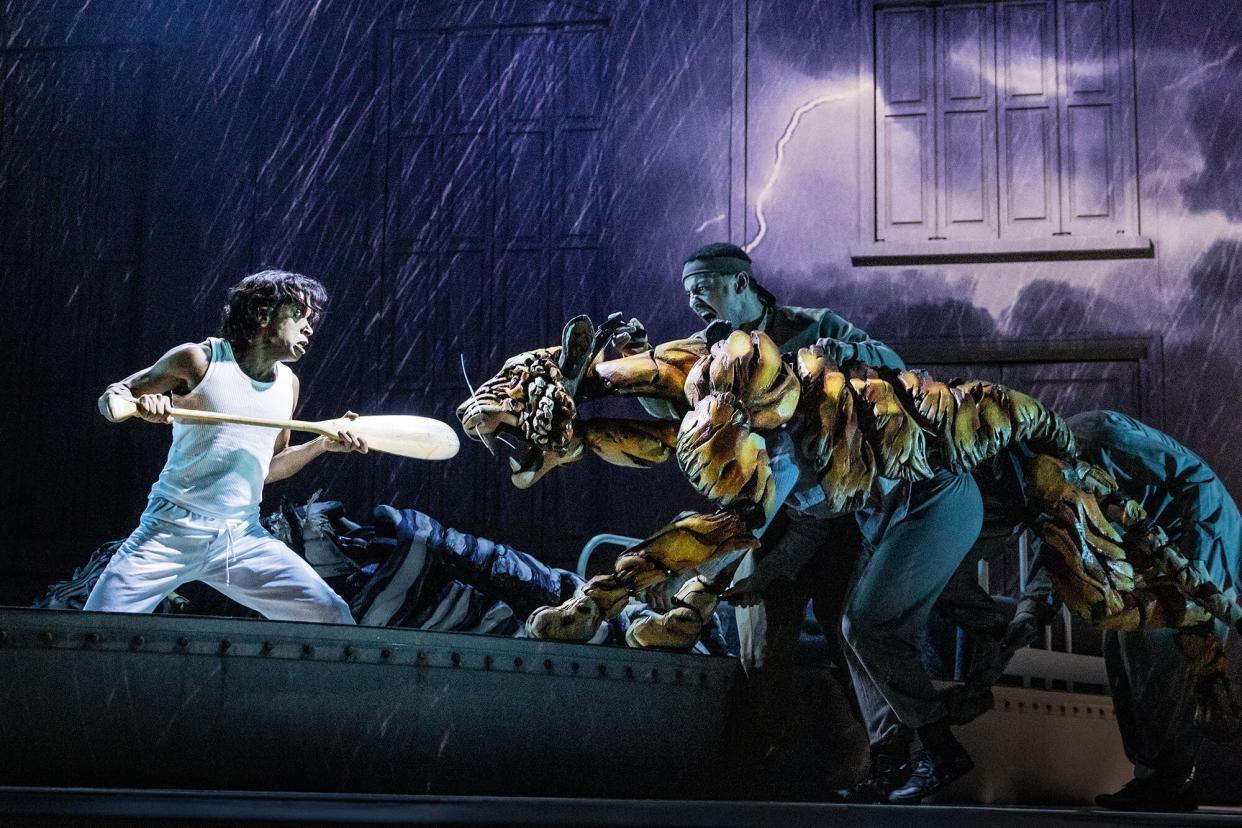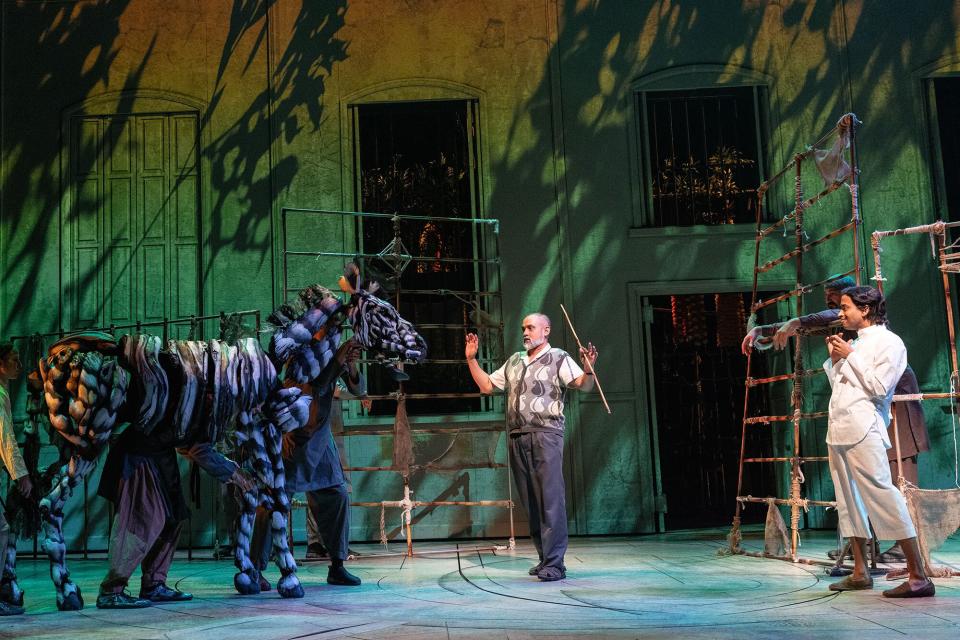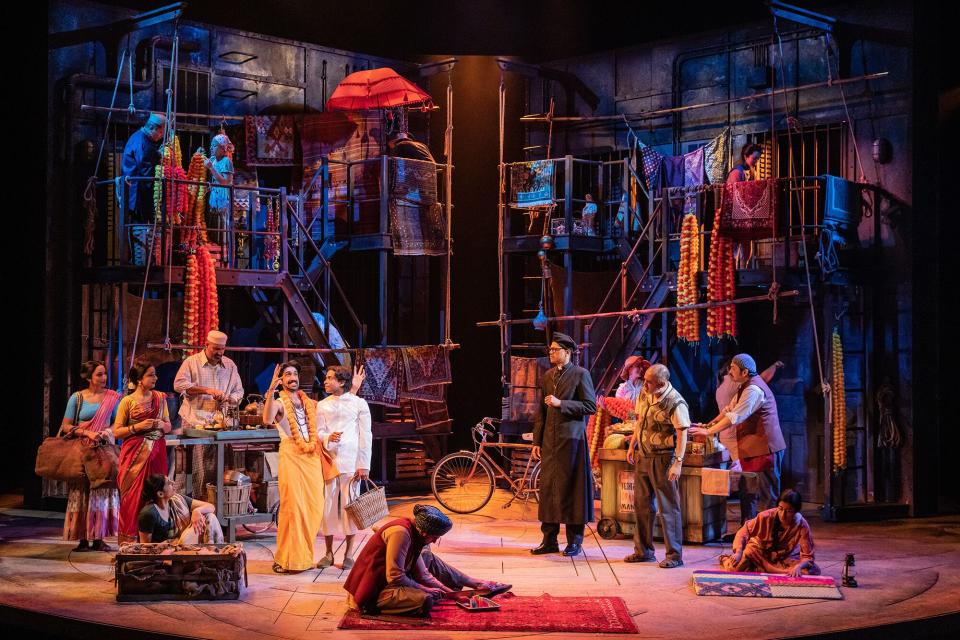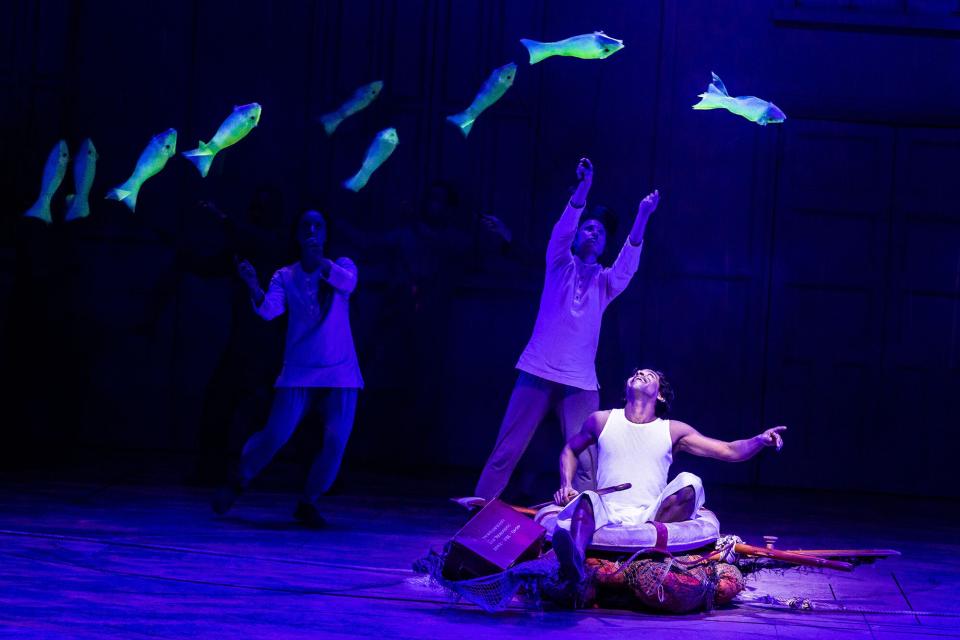Life of Pi review: The award-winning adaptation comes to stunning life on Broadway

- Oops!Something went wrong.Please try again later.
Matthew Murphy and Evan Zimmerman for MurphyMade Hiran Abeysekera and puppeteers Fred Davis, Scarlet Wilderink, and Andrew Wilson as Richard Parker in 'Life of Pi'
Since the release of Yann Martel's novel Life of Pi in 2001, it's become an international best-seller and the basis for Ang Lee's Oscar-winning film in 2012. More recently, it's become a five-time Olivier Award-winning theatrical production in London, and is now making its Broadway debut at the Gerald Schoenfeld Theatre in New York.
Creatively adapted by playwright Lolita Chakrabarti and directed with verve by Max Webster, the play opens in a Mexican hospital in 1978 as the youthful Pi Patel (the endearing Hiran Abeysekera, reprising the role that won him the Olivier Award) recounts how he wound up stranded at sea for the better part of a year with only a Bengal tiger to keep him company. Pi, short for Piscine, is the lone survivor of the Tsimtsum, a Japanese cargo ship that was lost at sea along with his family and most of the animals from his father's zoo in India.
When tragedy struck, his family was attempting to flee the political turmoil in India in the hopes of making a fresh start in Canada. Now, Pi must tell the Japanese insurance investigator Mr. Okamoto (Daisuke Tsuji) and the Canadian diplomat Lulu Chen (Kirstin Louie) what exactly happened during his 227 days at sea. As the reluctant Pi tells his tale, the stage transforms from a sterile hospital to a colorful zoo in Pondicherry, India. In doing so, this imaginative and powerful stage adaptation sparks to life.

Matthew Murphy and Evan Zimmerman for MurphyMade Rajesh Bose and Hiran Abeysekera in 'Life of Pi'
Vibrant puppet creations by Nick Barnes and Finn Caldwell serve as the wild animals in the Patel family zoo, and the innovative staging of these creatures invokes a sense of wonder that only grows as the play unfolds. Butterflies flit across the stage as a giraffe pokes its head through its cage to be fed by a more innocent Pi. Eventually, the breadth of the Patel's menagerie comes into focus as a zebra, orangutan, goat, and hyena parade by onstage as Pi's father (Rajesh Bose) chides his son for needlessly endangering himself around the animals. The gorgeously crafted puppets, along with some sensitive puppeteering, allow the animals to move as if independent of their puppeteers, who stealthily recede into the background. It's not the first time Broadway has seen such creative puppet work — The Lion King, obviously, is one long-standing example — but it's visually dazzling nonetheless.
As impressive as these puppets are, the true centerpiece of the show is the unusually named Bengal tiger Richard Parker. Animated by CGI in Ang Lee's Oscar-winning film, here the ferocious beast is activated by three puppeteers (Fred Davis, Scarlet Wilderink, and Andrew Wilson), whose precision and delicacy of movement is a wonder to behold. It's easy to see why the team behind the beast collectively won the Olivier Award for Best Supporting Actor. As charming as Abeysekera is as Pi (and he's very charming), if Richard Parker can't serve as a physical threat, the story loses its bite. Thankfully, that's not a concern and the rest of the beautiful production design by Tim Hatley supports the dance between Pi and the tiger.

Matthew Murphy and Evan Zimmerman for MurphyMade The cast of 'Life of Pi' on Broadway
Before that dance can happen, Pi and his family must depart India on that doomed cargo ship. The depiction of the shipwreck is a marvel of stagecraft, but it's the earlier scenes in India that help articulate the state of Pi's soul before he makes that fateful trip. What kind of young man is Pi? Well, he's the type who can't choose just one religion, so tries to practice being Hindu, Christian, and Muslim all at the same time to his family's consternation. His curiosity is matched by his imagination, sense of humor, and adaptability, some of the very traits that help him survive the ordeal.
And, as it's staged, it's quite the ordeal, with Tim Lutkin's lighting, Andrzej Goulding's video, and Carolyn Downing's sound creating the impression of a treacherous storm at sea. In Pi's retelling, his entire family is lost while the only survivors to make it into his lifeboat are a few of their animals. But a brutal game of predator and prey plays out amongst the beasts and soon only Pi and Richard Parker are left alive. With only a box of rations, some canned water, an umbrella, and a survival guide, Pi must learn how to tame Parker's lethal nature and keep the beast alive so he's not alone in his despair. Through hallucinations and ghostly visits from familiar figures, Pi finds the strength and wisdom to persist against impossible odds.

Matthew Murphy and Evan Zimmerman for MurphyMade Sonya Venugopal, Celia Mei Rubin, and Hiran Abeysekera in 'Life of Pi' on Broadway
Despite the dire situation, Pi manages to find the humor and wonder in the natural world around him. But, given that there's been no trace of Richard Parker since Pi's arrival on shore, Mr. Okamoto doubts Pi's story, believing the boy is using his prodigious imagination to hide from the harsh reality of his survival. Pi confronts these questions by telling a much darker but potentially more believable version of the story that gives the play a powerful twist. Is Pi's fantastical tale of being trapped with a Bengal tiger true or is Mr. Okamoto correct in thinking Pi is simply protecting himself from a more painful and traumatic truth? Intriguingly, the play omits both the book and the film's framing device of having Pi recount his tale as an older man, insinuating that this trauma remains fresh, no matter how good-humored Pi might seem.
The script, unfortunately, is not always on par with the fantastic production work. Occasionally, the action moves so quickly that the dialogue gets lost in the commotion. But these are small quibbles for such an impressive stage production. At 2 hours and 15 minutes, the play whizzes by and, while some younger children might find the action too intense, the older children and teens who attended my performance appeared rapt. Adaptations of Life of Pi have won everything from Oscars to the Booker Prize to Olivier Awards, and there is no doubt with this dazzling Broadway production that Tony Awards are sure to follow.
Related Content
Sweeney Todd review: Josh Groban and Annaleigh Ashford are a shear delight in Broadway revival
A Doll's House review: Jessica Chastain works hard to bring a minimalist re-up to life
Bad Cinderella review: Andrew Lloyd Webber's new musical is bibbidi-bobbidi-basic
Bob Fosse's Dancin' review: Sing, sing, singin' the praises of dance and a master of the craft

